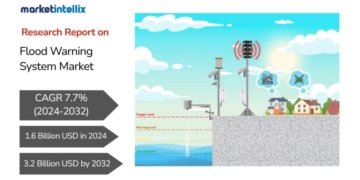Stay ahead with our updated market reports featuring the latest on tariffs, trade flows, and supply chain transformations.
IoT in Chemical Industry Market Size Valuation Forecast: What Will the Market Be Worth by 2025?
The market size of IoT in the chemical industry has witnessed substantial expansion in the past few years. The market, which stood at $80.38 billion in 2024, is projected to surge to $97.9 billion in 2025, indicating a compound annual growth rate (CAGR) of 21.8%. The historical growth of this market can be traced back to factors such as process optimization, asset management, regulatory compliance, predictive maintenance, energy efficiency, safety monitoring, and data analytics.
IoT in Chemical Industry Market Size Forecast: What’s the Projected Valuation by 2029?
The market size for IoT in the chemical industry is predicted to expand exponentially in the coming years, reaching $217.91 billion in 2029 with a CAGR of 22.1%. The projected growth during the forecast period can be credited to factors such as intelligent chemical plants, environmental surveillance, cybersecurity solutions, circular economy initiatives, and safety and security applications. Notable trends for this period encompass smart manufacturing and industry 4.0, the integration of AI and data analytics, partnerships with tech providers, cutting-edge sensors, digital twins, and the incorporation of blockchain.
View the full report here:
https://www.thebusinessresearchcompany.com/report/iot-in-chemical-industry-global-market-report
What Are the Drivers Transforming the IoT in Chemical Industry Market?
The expected surge in the IoT for the chemical industry market is largely attributed to the escalating utilization of industrial robots. These robots are engineered to automate manufacturing tasks, such as those mandated by a perpetually moving production line, and are stationed at fixed spots within an industrial plant. The chemical sector is set to undergo a transformation with the help of the Internet of Things. The data garnered from IoT-empowered devices enables prediction of future outcomes, trends, and the maintenance needs of machinery in a production line used by chemical industries. For example, as per the International Federation of Robotics, a non-profit organization in Germany, there was an overall growth of 12% in industrial robot installations in manufacturing reaching 41,624 units in 2022 compared to May 2023. Hence, the rise in industrial robot adoption is anticipated to enhance the IoT footprint in the chemical industry market.
Get your free sample here:
https://www.thebusinessresearchcompany.com/sample.aspx?id=9193&type=smp
What Long-Term Trends Will Define the Future of the IoT in Chemical Industry Market?
The increasing implementation of Internet of Things (IoT) platforms is a notable trend in the IoT for the chemical industry marketplace. Prominent companies in this market are keen on deploying industrial IoT platforms in chemical plants to maintain market relevance. In a case study from February 2023, German chemical corporation, BASF, formed a partnership with fellow German chemical company Thielmann GmbH & Co. KG and digital transformation service provider NXTGN Solutions GmbH. The objective was to advance the proliferation and commercialization of IoT-powered Intermediate Bulk Container (IBC) tracking systems. These tracking systems, enhanced through IoT, allow real-time supervision of varied parameters like location, fill volumes, temperature, and contamination. Such data is indispensable in the chemical sector, where precise tracking is crucial in guaranteeing safety and meeting regulatory requirements.
Which Segments in the IoT in Chemical Industry Market Offer the Most Profit Potential?
The IoT in chemical industry market covered in this report is segmented –
1) By Technology: Machine Vision, 3D Printing, Digital Twin, Plant Asset Management, Manufacturing Execution System, Distributed Control System, Industrial robotics, Big Data, Artificial Intelligence, AR Or VR
2) By Process: Research And Development, Procurement, Packaging, Supply Chain Management And Logistics
3) By End User: Metals And Mining, Food And Beverages, Chemical, Pharmaceutical, Pulp And Paper
Subsegments:
1) By Machine Vision: Quality Control Systems, Automated Inspection Systems
2) By 3D Printing: Additive Manufacturing For Prototyping, Customized Chemical Production
3) By Digital Twin: Real-Time Monitoring, Predictive Maintenance Models
4) By Plant Asset Management: Asset Performance Management, Maintenance Optimization
5) By Manufacturing Execution System (MES): Production Tracking, Workflow Management
6) By Distributed Control System (DCS): Process Control Systems, Automation Solutions
7) By Industrial Robotics: Robotic Process Automation, Collaborative Robots (Cobots)
8) By Big Data: Data Analytics And Insights, Process Optimization
9) By Artificial Intelligence: Machine Learning Algorithms, Predictive Analytics
10) By Augmented Reality (AR) Or Virtual Reality (VR): Training And Simulation, Remote Assistance And Maintenance
Tailor your insights and customize the full report here:
https://www.thebusinessresearchcompany.com/customise?id=9193&type=smp
Which Firms Dominate the IoT in Chemical Industry Market by Market Share and Revenue in 2025?
Major companies operating in the IoT in chemical industry market include Siemens AG, ABB Ltd., Altizon Inc., Atos SE, Cisco Systems Inc., General Electric Company, Honeywell International Inc., International Business Machines Corporation, Microsoft Corporation, Mitsubishi Electric Corporation, Robert Bosch GmbH, Rockwell Automation Inc., Schneider Electric SE, Yokogawa Electric Corporation, Accen*ture plc, SAP SE, Oracle Corporation, PTC Inc., Hitachi Ltd., Intel Corporation, Huawei Technologies Co. Ltd., Dell Technologies Inc., Hewlett Packard Enterprise Development LP, Fujitsu Limited, NEC Corporation, Infosys Limited, Wipro Limited, Tata Consultancy Services Limited, Aspen Technology Inc., Emerson Electric Co., OSIsoft LLC
Which Regions Offer the Highest Growth Potential in the IoT in Chemical Industry Market?
Asia-Pacific was the largest region in the IoT in the chemical industry market in 2024. The regions covered in the IoT in chemical industry market report are Asia-Pacific, Western Europe, Eastern Europe, North America, South America, Middle East, Africa
Purchase the full report today:
https://www.thebusinessresearchcompany.com/purchaseoptions.aspx?id=9193
This Report Supports:
1. Business Leaders & Investors – To identify growth opportunities, assess risks, and guide strategic decisions.
2. Manufacturers & Suppliers – To understand market trends, customer demand, and competitive positioning.
3. Policy Makers & Regulators – To track industry developments and align regulatory frameworks.
4. Consultants & Analysts – To support market entry, expansion strategies, and client advisory work.
Learn More About The Business Research Company
With over 15000+ reports from 27 industries covering 60+ geographies, The Business Research Company has built a reputation for offering comprehensive, data-rich research and insights. Armed with 1,500,000 datasets, the optimistic contribution of in-depth secondary research, and unique insights from industry leaders, you can get the information you need to stay ahead.
Our flagship product, the Global Market Model (GMM), is a premier market intelligence platform delivering comprehensive and updated forecasts to support informed decision-making.
Connect with us on:
LinkedIn: https://in.linkedin.com/company/the-business-research-company,
Twitter: https://twitter.com/tbrc_info,
YouTube: https://www.youtube.com/channel/UC24_fI0rV8cR5DxlCpgmyFQ.
Contact Us
Europe: +44 7882 955267,
Asia: +91 88972 63534,
Americas: +1 310-496-7795 or
Email: mailto:info@tbrc.info
Learn More About The Business Research Company
With over 15,000+ reports from 27 industries covering 60+ geographies, The Business Research Company has built a reputation for offering comprehensive, data-rich research and insights. Our flagship product, the Global Market Model delivers comprehensive and updated forecasts to support informed decision-making.
This release was published on openPR.

















